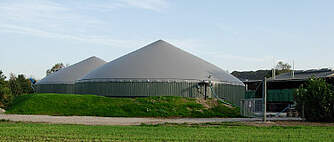Where appropriate, the substrates are shredded as a pretreatment. Solids are delivered into the digester via a solid input device with buffer tank, which conveys the dosed substrate into the digester. The digester consists of an airtight, coated steel or concrete tank. This is provided with insulation, since a constant temperature needs to be maintained inside for the microorganisms. The digester is designed to withstand either mesophilic temperatures (approximately 35° C) or thermophilic temperatures (approximately 55° C). Inside the digester is a central agitator or between one and several other agitators, which ensure the essential complete mixing of the digester contents. It is important to ensure that no floating layer forms on the substrate surface and that no sedimentation is produced on the bottom of the tank. Moreover, the microorganisms must be supplied with all the necessary nutrients and the heat must be distributed homogenously. Secondary digesters and storage tanks are usually downstream of the digester. The average minimum retention period in the digester is 20 days for liquid manure. Energy crops and crop residues require retention time of at least 40 days. During this time, the organic substances are metabolised by the microorganisms. This produces two different end products: biogas and digested substrate.
The digestate, which is temporarily stored on-site, is mostly used as fertiliser due to its high nutrient content.
The biogas is temporarily stored in gas holder roofs, which are located on the secondary digester and on the storage tank, for example. As a rule CHPs, which generate heat as well as electricity in cogeneration, are supplied with the biogas. In the event that the engine or engines are not in operation yet biogas is still generated, the plants are equipped with an emergency flare, which can be used to burn off the excess biogas. Other satellite CHPs are often also operated, supplied via a biogas pipeline, in addition to the CHP at the plant location, which secures the heat supply for the plant. Satellite CHPs are operated at other locations where the heat produced also can be used. The regenerative electricity generated can be used for own consumption or is fed into the power supply grid and sold. The heat generated can be used to heat stables and/or for residential heating, for drying grain and for other purposes. Around 10 to a maximum 30 %, in extreme cases, of the energy generated is required to operate the biogas plant, depending on the proportion of liquid manure. Of course there are also other options for using biogas. For example, the entire quantity of biogas can be used for heat production, in the form of steam or hot water. Where appropriate, the steam can also be used for cooling. In biogas treatment plants, biogas can be processed to meet natural gas specifications and fed into the gas network in the form of biomethane.


